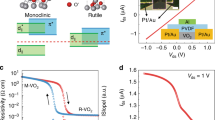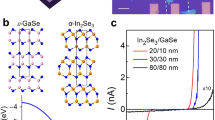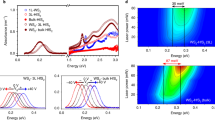Abstract
Unipolar barrier structures are used to suppress dark current in photodetectors by blocking majority carriers. Designing unipolar barriers with conventional materials is challenging due to the strict requirements of lattice and band matching. Two-dimensional materials have self-passivated surfaces and tunable band structures, and can thus be used to design unipolar barriers in which lattice mismatch and interface defects are avoided. Here, we show that band-engineered van der Waals heterostructures can be used to build visible and mid-wavelength infrared unipolar barrier photodetectors. Our nBn unipolar barrier photodetectors, which are based on a tungsten disulfide/hexagonal boron nitride/palladium diselenide heterostructure, exhibit a low dark current of 15 pA, a photocurrent of 20 μA and a detectivity of 2.7 × 1012 cm Hz1/2 W−1. Our pBp unipolar barrier photodetectors, which are based on a black phosphorus/molybdenum disulfide/graphene heterostructure, exhibit a room-temperature detectivity of 2.3 × 1010 cm Hz1/2 W−1 in the mid-wavelength infrared region under blackbody radiation. The pBp devices also show a dichroic ratio of 4.9 under blackbody radiation, and a response time of 23 μs under 2 μm laser illumination.
This is a preview of subscription content, access via your institution
Access options
Access Nature and 54 other Nature Portfolio journals
Get Nature+, our best-value online-access subscription
$29.99 / 30 days
cancel any time
Subscribe to this journal
Receive 12 digital issues and online access to articles
$119.00 per year
only $9.92 per issue
Buy this article
- Purchase on Springer Link
- Instant access to full article PDF
Prices may be subject to local taxes which are calculated during checkout




Similar content being viewed by others
Data availability
Data that support the findings of this study are available from the corresponding authors upon reasonable request. Source data are provided with this paper.
References
Martyniuk, P., Kopytko, M. & Rogalski, A. Barrier infrared detectors. Opto-Electron. Rev. 22, 127–146 (2014).
Maimon, S. & Wicks, G. W. nBn detector, an infrared detector with reduced dark current and higher operating temperature. Appl. Phys. Lett. 89, 151109 (2006).
Kim, H. S. et al. Long-wave infrared nBn photodetectors based on InAs/InAsSb type-II superlattices. Appl. Phys. Lett. 101, 159 (2012).
Kopytko, M. & Rogalski, A. HgCdTe barrier infrared detectors. Prog. Quantum Electron. 47, 1–18 (2016).
Lei, W., Antoszewski, J. & Faraone, L. Progress, challenges, and opportunities for HgCdTe infrared materials and detectors. Appl. Phys. Rev. 2, 041303 (2015).
Xia, F., Wang, H., Xiao, D., Dubey, M. & Ramasubramaniam, A. Two-dimensional material nanophotonics. Nat. Photon. 8, 899–907 (2014).
Liu, C. et al. Two-dimensional materials for next-generation computing technologies. Nat. Nanotechnol. 15, 545–557 (2020).
Liu, Y., Huang, Y. & Duan, X. Van der Waals integration before and beyond two-dimensional materials. Nature 567, 323–333 (2019).
Li, L. et al. Direct observation of the layer-dependent electronic structure in phosphorene. Nat. Nanotechnol. 12, 21–25 (2017).
Guo, Q. et al. Efficient electrical detection of mid-infrared graphene plasmons at room temperature. Nat. Mater. 17, 986–992 (2018).
Deng, B. et al. Strong mid-infrared photoresponse in small-twist-angle bilayer graphene. Nat. Photon. 14, 549–553 (2020).
Chen, X. et al. Widely tunable black phosphorus mid-infrared photodetector. Nat. Commun. 8, 1672 (2017).
Youngblood, N., Chen, C., Koester, S. J. & Li, M. Waveguide-integrated black phosphorus photodetector with high responsivity and low dark current. Nat. Photon. 9, 247–252 (2015).
Huang, M. et al. Multifunctional high-performance van der Waals heterostructures. Nat. Nanotechnol. 12, 1148–1154 (2017).
Tu, L. et al. Ultrasensitive negative capacitance phototransistors. Nat. Commun. 11, 101 (2020).
Yu, X. et al. Atomically thin noble metal dichalcogenide: a broadband mid-infrared semiconductor. Nat. Commun. 9, 1545 (2018).
Amani, M., Regan, E., Bullock, J., Ahn, G. H. & Javey, A. Mid-wave infrared photoconductors based on black phosphorus–arsenic alloys. ACS Nano 11, 11724–11731 (2017).
Buscema, M. et al. Fast and broadband photoresponse of few-layer black phosphorus field-effect transistors. Nano Lett. 14, 3347–3352 (2014).
Wu, F. et al. High efficiency and fast van der Waals hetero-photodiodes with a unilateral depletion region. Nat. Commun. 10, 4663 (2019).
Gao, A. et al. Observation of ballistic avalanche phenomena in nanoscale vertical InSe/BP heterostructures. Nat. Nanotechnol. 14, 217–222 (2019).
Fu, Q. et al. Ultrasensitive 2D Bi2O2Se phototransistors on silicon substrates. Adv. Mater. 31, 1804945 (2019).
Suh, J. et al. Reconfiguring crystal and electronic structures of MoS2 by substitutional doping. Nat. Commun. 9, 199 (2018).
Zhao, Y. et al. Doping, contact and interface engineering of two-dimensional layered transition metal dichalcogenides transistors. Adv. Funct. Mater. 27, 1603484 (2017).
Savich, G. R., Pedrazzani, J. R., Sidor, D. E., Maimon, S. & Wicks, G. W. Dark current filtering in unipolar barrier infrared detectors. Appl. Phys. Lett. 99, 121112 (2011).
Savich, G. R., Pedrazzani, J. R., Sidor, D. E. & Wicks, G. W. Benefits and limitations of unipolar barriers in infrared photodetectors. Infrared Phys. Technol. 59, 152–155 (2013).
Chow, W. L. et al. High mobility 2D palladium diselenide field-effect transistors with tunable ambipolar characteristics. Adv. Mater. 29, 1602969 (2013).
Shi, Z. et al. Vapor–liquid–solid growth of large-area multilayer hexagonal boron nitride on dielectric substrates. Nat. Commun. 11, 849 (2020).
Hong, X. et al. Ultrafast charge transfer in atomically thin MoS2/WS2 heterostructures. Nat. Nanotechnol. 9, 682–686 (2014).
Sun, J. et al. Lateral 2D WSe2 p–n homojunction formed by efficient charge-carrier-type modulation for high-performance optoelectronics. Adv. Mater. 32, 1906499 (2020).
Li, L. et al. Black phosphorus field-effect transistors. Nat. Nanotechnol. 9, 372–377 (2014).
Martyniuk, P., Gawron, W. & Rogalski, A. Theoretical modeling of HOT HgCdTe barrier detectors for the mid-wave infrared range. J. Electron. Mater. 42, 3309–3319 (2013).
Itsuno, A. M., Phillips, J. D. & Velicu, S. Design and modeling of HgCdTe nBn detectors. J. Electron. Mater. 40, 1624–1629 (2011).
Kuzum, D. et al. Transparent and flexible low noise graphene electrodes for simultaneous electrophysiology and neuroimaging. Nat. Commun. 5, 5259 (2014).
Wang, J. et al. High mobility MoS2 transistor with low Schottky barrier contact by using atomic thick h-BN as a tunneling layer. Adv. Mater. 28, 8302–8308 (2016).
Yuan, H. et al. Polarization-sensitive broadband photodetector using a black phosphorus vertical p–n junction. Nat. Nanotechnol. 10, 707–713 (2015).
Xia, F., Wang, H. & Jia, Y. Rediscovering black phosphorus as an anisotropic layered material for optoelectronics and electronics. Nat. Commun. 5, 4458 (2014).
Bullock, J. et al. Polarization-resolved black phosphorus/molybdenum disulfide mid-wave infrared photodiodes with high detectivity at room temperature. Nat. Photon. 12, 601–607 (2018).
Lee, Y. T. et al. Nonvolatile charge injection memory based on black phosphorous 2D nanosheets for charge trapping and active channel layers. Adv. Funct. Mater. 26, 5701–5707 (2016).
Kim, K. S. et al. Ultrasensitive MoS2 photodetector by serial nano-bridge multi-heterojunction. Nat. Commun. 10, 4701 (2019).
Vu, Q. A. et al. Tuning carrier tunneling in van der Waals heterostructures for ultrahigh detectivity. Nano Lett. 17, 453–459 (2017).
Kopytko, M. et al. Engineering the bandgap of unipolar HgCdTe-Based nBn infrared photodetectors. J. Electron. Mater. 44, 158–166 (2014).
Itsuno, A. M., Phillips, J. D. & Velicu, S. Mid-wave infrared HgCdTe nBn photodetector. Appl. Phys. Lett. 100, 161102 (2012).
Wu, D. H., Zhang, Y. Y. & Razeghi, M. Room temperature operation of InxGa1−xSb/InAs type-II quantum well infrared photodetectors grown by MOCVD. Appl. Phys. Lett. 112, 111103 (2018).
Mehew, J. D. et al. Fast and highly sensitive ionic-polymer-gated WS2–graphene photodetectors. Adv. Mater. 29, 1700222 (2017).
Saran, R. & Curry, R. J. Lead sulphide nanocrystal photodetector technologies. Nat. Photon. 10, 81–92 (2016).
Acknowledgements
W.H. acknowledges support from the National Natural Science Foundation of China (grant nos. 61725505, 11734016 and 61521005), National Key Research and Development Programme of China (grant no. 2020YFB2009300), Research Project of Frontier Science of CAS (grant no. QYZDB-SSW-JSC031) and Fund of Shanghai Natural Science Foundation (grant no. 19XD1404100). Yunfeng Chen and Z.W. acknowledge support from the Fund of SITP Innovation Foundation (grant nos. CX-235 and 348).
Author information
Authors and Affiliations
Contributions
W.H. and P.Z. conceived the idea and designed the experiments. Yunfeng Chen and Y.W. carried out most of the experiments and analysed the data. P.W., P.Z., J.M., X.Chen, W.L. and Z.H. analysed the data. Y.G., R.X. and Q.L. contributed to the theoretical calculations. Y.Y. and F.W. performed Raman measurements. X.Chai and Y.Z. carried out Fourier transform infrared measurements. J.Y. and L.Z. conducted the atomic force microscopy measurements. Yan Chen and J.W. conducted the Kelvin probe force microscopy measurements. W.H. was responsible for project planning. Yunfeng Chen, Y.W., Z.W., P.Z. and W.H. co-wrote the manuscript. All authors discussed the results.
Corresponding authors
Ethics declarations
Competing interests
The authors declare no competing interests.
Additional information
Peer review information Nature Electronics thanks Jiansheng Jie and the other, anonymous, reviewer(s) for their contribution to the peer review of this work.
Publisher’s note Springer Nature remains neutral with regard to jurisdictional claims in published maps and institutional affiliations.
Supplementary information
Supplementary Information
Supplementary Figs, 1–33, Tables 1 and 2 and notes 1 and 2.
Supplementary Data 1
Statistical supplementary data.
Source data
Source Data Fig. 2
Statistical source data.
Source Data Fig. 3
Statistical source data.
Source Data Fig. 4
Statistical source data.
Rights and permissions
About this article
Cite this article
Chen, Y., Wang, Y., Wang, Z. et al. Unipolar barrier photodetectors based on van der Waals heterostructures. Nat Electron 4, 357–363 (2021). https://doi.org/10.1038/s41928-021-00586-w
Received:
Accepted:
Published:
Issue Date:
DOI: https://doi.org/10.1038/s41928-021-00586-w
This article is cited by
-
Multidimensional detection enabled by twisted black arsenic–phosphorus homojunctions
Nature Nanotechnology (2024)
-
On-chip optoelectronic logic gates operating in the telecom band
Nature Photonics (2024)
-
In-situ fabrication of on-chip 1T’-MoTe2/Ge Schottky junction photodetector for self-powered broadband infrared imaging and position sensing
Nano Research (2024)
-
Realization of flexible in-memory computing in a van der Waals ferroelectric heterostructure tri-gate transistor
Nano Research (2024)
-
Lattice-mismatch-free construction of III-V/chalcogenide core-shell heterostructure nanowires
Nature Communications (2023)



